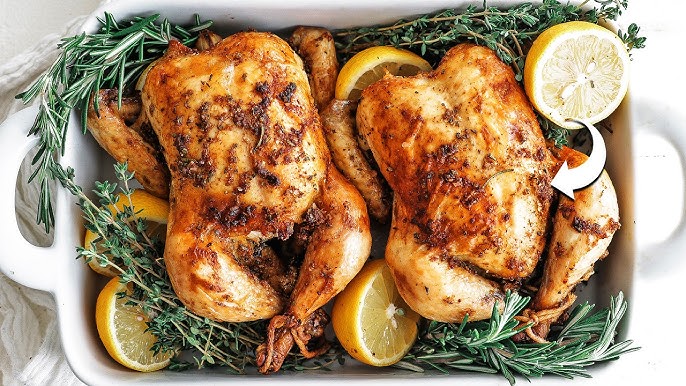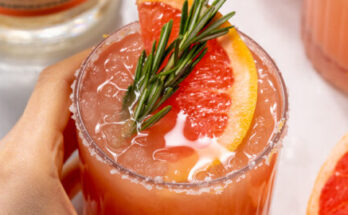Cornish Hens Recipe: Cornish hens, often referred to as Cornish game hens, are small, tender chickens that typically weigh around 1 to 1.5 pounds each. Despite their name, they’re not a different species—they’re just young chickens with a delicate texture and mild flavor. Their smaller size makes them ideal for individual servings, and they cook more quickly than larger poultry. These little birds have been a gourmet favorite for decades, gracing dinner tables during holidays, anniversaries, and special date nights.
They offer a perfect mix of elegance and practicality. You can serve one hen per person for an impressive presentation, and because they’re petite, you can experiment with different seasonings or stuffing combinations without committing to a huge portion.
In this guide, we’ll walk you through everything—from selecting the freshest hens to serving them hot and juicy on the table.
What Are Cornish Hens?
Cornish hens are a hybrid breed, typically a cross between the Cornish and White Plymouth Rock chickens. They reach market size quickly—usually within five to six weeks—resulting in tender meat. Unlike regular chickens, they are almost always sold whole and individually wrapped.
One of the most appealing features is their portion size. A standard Cornish hen is perfect for one to two servings, making them ideal for intimate gatherings. They have a slightly milder taste compared to larger chickens, which means they pair beautifully with herbs, citrus, garlic, and a wide variety of spices.
Because of their compact build, they cook evenly and more quickly than a larger bird. This not only saves time but also reduces the risk of drying out the meat—a common issue with larger poultry. Whether roasted golden-brown in the oven or kissed by smoky grill marks, Cornish hens always deliver on flavor and presentation.
Why They’re Perfect for Special Occasions
Cornish hens elevate any meal instantly. Their petite size and golden, crispy skin make for a visually stunning plate that looks like something you’d see in a fine-dining restaurant. They’re the kind of main course that makes your guests say “Wow” before they even take a bite.
For holidays like Thanksgiving or Christmas, they offer a fantastic alternative to cooking one massive turkey. This way, each guest gets their own perfectly cooked bird, and you avoid the drama of uneven cooking. They’re also a great choice for Valentine’s Day dinners, anniversaries, or any time you want to impress without spending the entire day in the kitchen.
Another benefit? They’re incredibly adaptable to different flavor profiles. You can prepare them with a classic herb and butter rub, go Mediterranean with lemon and rosemary, or lean into bold spices for a more exotic feel. Whatever your menu theme, Cornish hens can fit right in and shine as the centerpiece.
Ingredients You’ll Need
Cooking perfect Cornish hens starts with having the right ingredients. The beauty of this dish is that you don’t need a long grocery list—quality over quantity is the secret.
Main Ingredients for Cornish Hens
- Cornish hens: 1 per person (about 1 to 1.5 pounds each)
- Butter or olive oil: For basting and crisping the skin
- Salt and black pepper: Essential for seasoning the meat
- Garlic cloves: Adds deep, aromatic flavor
- Fresh herbs: Such as rosemary, thyme, and parsley for freshness
- Lemon: For brightness and acidity
Optional Additions for Extra Flavor
- Paprika: For color and mild smokiness
- Onions: Roasted alongside for extra sweetness
- White wine or chicken broth: For a moist roasting environment
- Honey or maple syrup: For a touch of sweetness in glazes
Ingredient Substitutions
- Olive oil can replace butter for a dairy-free version.
- Lime can substitute lemon for a different citrus note.
- Dried herbs can replace fresh herbs if needed—just reduce the amount by half since dried herbs are more concentrated.
The key is balance—too much seasoning can overpower the delicate meat, while too little may leave it bland. Aim for layers of flavor rather than one overwhelming note.
Essential Kitchen Tools
Having the right tools ensures your Cornish hens turn out perfectly cooked and beautifully presented.
Cooking Equipment
- Roasting pan: Large enough to hold all hens without overcrowding
- Oven-safe rack: Allows heat to circulate and crisps the skin
- Basting brush: For applying butter, oil, or glazes evenly
- Meat thermometer: To ensure accurate cooking
Measuring and Preparation Tools
- Measuring spoons and cups: For precise seasoning
- Cutting board and sharp knife: For prepping herbs, garlic, and lemons
- Mixing bowls: For marinades or stuffing
- Kitchen twine: Useful for trussing the hens so they cook evenly
These tools aren’t just nice-to-haves—they’re the backbone of a smooth cooking process. Investing in them will make your cooking experience easier and your results more consistent.
Preparing the Cornish Hens
Preparation is where the magic begins. Cornish hens may be small, but they deserve the same level of care as any fine roast. The first step is to remove the hens from the packaging and pat them dry with paper towels. This helps the skin crisp up during cooking. You’ll often find a small packet of giblets inside the cavity—remove and set these aside (they can be used for gravy or stock if you wish).
Inspect the hens for any stray feathers or excess fat. A quick trim with kitchen scissors can tidy them up for a cleaner presentation. Once trimmed, rinse them briefly under cold water, then pat dry again. Moisture is the enemy of crisp skin, so don’t skip this step.
From here, you have two main options: cook the hens plain with a simple seasoning of salt and pepper, or take them up a notch by marinating. Marinating infuses the meat with deeper flavor and can be tailored to your theme—think lemon-garlic for Mediterranean, soy-ginger for Asian flair, or paprika-cumin for a smoky touch.
If you’re planning to stuff your hens, now is the time to prepare your filling. Popular stuffings include a simple herb and breadcrumb mixture, wild rice with cranberries, or even roasted vegetables. Stuff lightly; overpacking can prevent the inside from cooking evenly.
Before cooking, consider trussing the hens (tying the legs together with kitchen twine). This not only keeps the stuffing in place but also helps the birds cook more evenly and retain their shape for a picture-perfect presentation.
Cooking Methods for Cornish Hens
One of the joys of Cornish hens is their adaptability—you can roast them, grill them, or slow-cook them. Each method offers a slightly different flavor and texture profile.
Roasting in the Oven
This is the most common method and delivers beautifully crisp skin with tender, juicy meat. You’ll need a preheated oven (usually 375–400°F) and about 45–60 minutes of cooking time, depending on the size of the hens. Basting during cooking keeps them moist and enhances flavor.
Grilling for a Smoky Finish
Grilling infuses the hens with a wonderful smokiness and charred edges. Use indirect heat to prevent burning and turn them occasionally for even cooking. Marinades with a touch of sweetness, like honey or balsamic, work wonderfully on the grill as they caramelize beautifully.
Slow Cooking for Tender Results
If you prefer a set-it-and-forget-it approach, slow cooking is a great option. While you won’t get crispy skin, the meat will be fall-off-the-bone tender. Adding vegetables and broth turns it into a complete one-pot meal.
Choosing your method often comes down to the time you have available and the flavor profile you want to achieve. For special occasions, roasting or grilling is best for presentation, while slow cooking is ideal for casual, comforting meals.
Step-by-Step Guide to Perfect Roasted Cornish Hens
Now that you know your preparation options, let’s go through a classic roasted Cornish hens recipe.
Step 1: Preheat the Oven
Set your oven to 375°F (190°C). A consistent temperature is key to even cooking.
Step 2: Prepare the Hens
Pat them dry, season generously inside and out with salt, pepper, and herbs. Place half a lemon and a garlic clove inside each cavity for aromatic steam as they roast.
Step 3: Arrange in the Pan
Place the hens breast-side up on a roasting rack in a pan. The rack allows hot air to circulate, crisping the skin on all sides.
Step 4: Add Moisture
Pour a cup of chicken broth or white wine into the pan to keep the meat moist and create a flavorful base for gravy.
Step 5: Roast and Baste
Cook for 45–60 minutes, basting every 20 minutes with melted butter or pan juices. This builds layers of flavor and enhances browning.
Step 6: Check for Doneness
Use a meat thermometer to ensure the thickest part of the thigh reaches 165°F (74°C).
Following these steps yields hens that are crispy outside, juicy inside, and infused with flavor from skin to bone.
How to Check for Doneness
Undercooking poultry is unsafe, and overcooking robs it of juiciness. The most reliable way to check is with a digital meat thermometer. Insert it into the thickest part of the thigh (avoiding the bone) and look for a reading of 165°F (74°C).
Visual clues also help—clear juices running from the meat, no pink near the bone, and skin that’s golden and taut. Pressing gently on the breast should produce a firm but slightly springy feel, indicating that the meat is cooked through without being dry.
If you don’t have a thermometer, cut between the thigh and body to check the juices. However, this releases moisture, so use this method only if necessary. A thermometer is worth the investment and removes guesswork entirely.
Remember that hens will continue to cook slightly after removal from the oven due to carryover heat. Let them rest for 10–15 minutes before serving; this redistributes juices and ensures each bite is tender and flavorful.
Serving Suggestions
Cornish hens deserve sides that complement without overshadowing them. Classic pairings include:
- Roasted vegetables like carrots, potatoes, and Brussels sprouts
- Wild rice or couscous for a hearty grain base
- Fresh salads with citrus dressings to balance the richness
- Herb-infused gravy or a light lemon-butter sauce for moisture and depth
For a festive touch, garnish with fresh herbs and lemon wedges. Serving each hen whole makes for an impressive plate, but you can also split them in half for smaller portions.
Wine pairings? A crisp Chardonnay or a Pinot Noir both work beautifully depending on your seasoning. For a non-alcoholic option, try sparkling water with a splash of lemon or pomegranate juice to keep the meal feeling special.
Storing and Reheating Leftovers
Cornish hens reheat well if you store them correctly. The first step is to allow the hens to cool slightly at room temperature—about 20 minutes—before storing. This prevents condensation, which can make the skin soggy. Wrap each hen tightly in aluminum foil or place it in an airtight container. If you have leftover gravy or pan juices, store them separately to add moisture during reheating.
For short-term storage, keep the hens in the refrigerator for up to 3–4 days. If you plan to keep them longer, freezing is the best option. Wrap each hen in plastic wrap, then foil, and store in a freezer-safe bag. Properly frozen, they’ll maintain quality for up to 3 months.
When reheating, the goal is to warm the meat through without drying it out. The oven is the best method—preheat to 325°F (163°C), place the hens in a baking dish, and cover loosely with foil. If you saved any broth or juices, drizzle some over the hens before reheating to lock in moisture. Heat for 15–20 minutes or until the internal temperature reaches 165°F (74°C).
Avoid reheating in the microwave if possible, as it tends to make the meat rubbery and the skin limp. If you must use the microwave, place the meat in a covered dish with a small splash of broth, heating in short bursts to prevent overcooking.
Leftover Cornish hens also make excellent additions to salads, sandwiches, or soups. The tender meat shreds easily and carries seasoning well, meaning your second meal can be just as delicious as the first.
Common Mistakes to Avoid
Even experienced cooks can make errors when preparing Cornish hens. The first big mistake is overcrowding the pan. If the hens are too close together, steam builds up, preventing the skin from crisping. Always give them space to breathe.
Another common issue is skipping the pat-dry step. Moisture is the enemy of crispy skin—always dry your hens before seasoning.
Overcooking is a danger with small birds because they reach doneness quickly. That’s why a meat thermometer is essential; guessing almost always leads to dry meat.
Underseasoning is equally problematic. While you don’t want to overpower the delicate flavor, remember that poultry benefits from generous seasoning, especially inside the cavity.
Some people forget to let the hens rest before serving, which causes juices to run out when cutting, leaving the meat less moist.
Finally, avoid using too high a temperature in an attempt to cook faster. This can burn the skin before the inside is cooked through. Steady, moderate heat yields the best results.
Nutritional Information
Cornish hens are a healthy choice for a protein-rich meal. A typical 1-pound hen (without stuffing) contains roughly:
- Calories: 250–300
- Protein: 25–28g
- Fat: 16–18g
- Carbohydrates: 0g (unless stuffed)
They’re an excellent source of B vitamins, particularly niacin (B3) and vitamin B6, which support metabolism and energy production. They also provide essential minerals such as phosphorus, selenium, and zinc—important for bone health, immune function, and cell repair.
Compared to larger chickens, Cornish hens offer a slightly higher skin-to-meat ratio, meaning more flavor per bite. While the skin does contain saturated fat, it’s also where much of the taste resides, so you can choose to eat it in moderation or remove it if you prefer a leaner meal.
Paired with vegetables and whole grains, Cornish hens fit well into a balanced diet. They’re also naturally gluten-free and low in carbs, making them suitable for paleo, keto, and low-carb eating plans.
Tips for Beginners
If you’re cooking Cornish hens for the first time, start simple. Use fresh herbs, salt, pepper, and butter for your first attempt. Once you’ve mastered the basics, you can experiment with marinades, glazes, and stuffing.
Always work with hens that are fully thawed; partially frozen meat cooks unevenly. Thaw them in the refrigerator for 24–36 hours or in cold water (changing the water every 30 minutes) for a faster method.
Preheat your oven and use a roasting rack—these two small steps make a big difference in achieving that golden-brown skin. Keep a close eye on the cooking time and check the temperature early to avoid overcooking.
If you’re nervous about serving them whole, you can spatchcock the hens (remove the backbone and flatten them) for quicker cooking and easier carving. This method also exposes more skin to direct heat, giving you extra crispiness.
Lastly, don’t be intimidated. Cornish hens may look fancy, but they’re no more difficult to prepare than a regular roast chicken—just smaller and faster.
Advanced Variations
Once you’ve mastered the classic roast, there are endless ways to customize Cornish hens.
Herb-Crusted Cornish Hens: Coat the hens in a mixture of finely chopped rosemary, thyme, parsley, garlic, and breadcrumbs before roasting. This adds texture and an aromatic punch.
Glazed Cornish Hens: Brush the hens with a glaze of honey, soy sauce, and balsamic vinegar during the last 15 minutes of cooking for a sweet-savory finish.
Stuffed Cornish Hens with Wild Rice and Cranberries: A festive option perfect for holidays. The rice absorbs the juices from the meat, making it rich and flavorful.
Mediterranean-Style Cornish Hens: Marinate with olive oil, lemon juice, oregano, and garlic, then serve with roasted vegetables and tzatziki sauce.
You can even try smoking the hens over applewood chips for a rustic, deep flavor. The small size means they absorb smoke quickly, making this a rewarding weekend cooking project.
FAQs about Cornish Hens Recipe
1. Can I cook Cornish hens from frozen?
It’s best to thaw them first for even cooking, but you can roast from frozen—just add 50% more cooking time.
2. Should I brine Cornish hens?
Brining enhances juiciness and flavor but is optional if you season well.
3. Can I cook multiple hens at once?
Yes, just ensure they’re not touching in the pan so heat circulates evenly.
4. What’s the best seasoning for Cornish hens?
A mix of fresh herbs, garlic, lemon, and butter is a classic starting point.
5. How long should I let them rest after cooking?
About 10–15 minutes, loosely covered with foil, to keep them juicy.
Conclusion
Cornish hens are the perfect blend of elegance, flavor, and convenience. Their petite size makes them ideal for individual servings, and they adapt beautifully to a variety of cooking methods and flavor profiles. Whether you’re hosting a holiday dinner, a romantic meal for two, or simply want to try something new, this guide equips you with everything you need—from selecting ingredients to serving the finished dish.
With the right preparation and attention to detail, you’ll serve Cornish hens that are crispy on the outside, juicy on the inside, and bursting with flavor in every bite.



